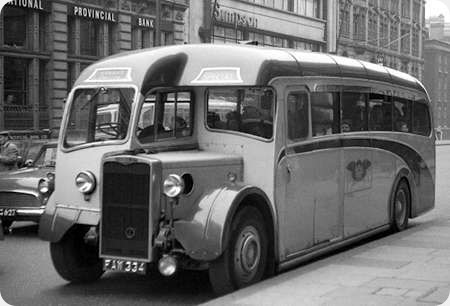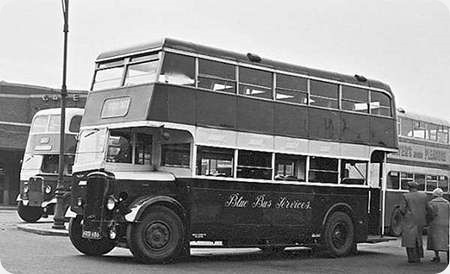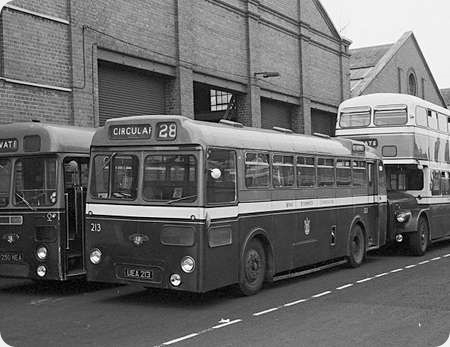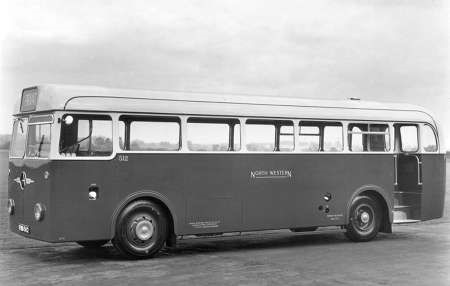A. Davies – Crossley SD – FAW 334
A. Davies, Acton Burnell
1949
Crossley SD 42/7
Plaxton C33F
Photographed in Piccadilly, London, in 1961 is the Crossley SD42/7 with Plaxton C33F body bought new by A. Davies (Transport) of Acton Burnell near Shrewsbury, Shropshire in March 1949. To address the shortcomings of the Crossley diesel engine the new AEC designed downdraught HOE7/5 began appearing during 1949, but the March 1949 delivery date of this coach – the chassis must have been produced some time earlier – suggests that it was fitted with the unmodified HOE7/4. In practice, as with the Daimler CD6 engine, the use of the HOE7/4 in single deckers, particularly coaches not subjected to intense stop/start work, taxed the power plant rather less severely than in double deckers, and it generally performed satisfactorily on such duties. This is borne out by the retention of FAW 334 by its original operator for a full working life, and, happily, this coach still exists today:- www.classicbuses.co.uk/faw334.JPG
Photograph and Copy contributed by Roger Cox
11/03/21 – 08:15
My experience of Crossleys was really only with Portsmouth Corporation, which had a sprinkling of DD42/5s with rather fragile locally-built Reading bodies loosely resembling their Craven-bodied trolleybuses at the front. However, their DD42/7s, with very attractive and sturdy Crossley bodies, always impressed me. Of course, the let down was their engines, but, coupled to turbo converters, they made a unique sound, with only two engine notes, either hard up on the governors when accelerating, or on tick-over when coasting along to the next bus stop. And then the Corporation finally decided that the fuel consumption was too much and replaced the mechanicals with renovated Leyland TD7 engines/gearboxes from scrapped buses. Then, to my ears, they sounded very out of keeping! It was a sad day for me, though, when their numbers dwindled….and then they were gone.
Chris Hebbron
19/03/21 – 06:56
The Brockhouse Turbo Transmitter transmission evolved from the pre war designs of Piero Salerni, a non Fascist Italian long resident in Britain with an English wife. One of his earliest transmissions was in a Tilling-Stevens B10 in 1932, and he continued to develop his designs in several applications, including private cars, in the years up to WW2. During the later 1930s he worked for the Ministry of Aircraft Production until, in the fraught political circumstances of wartime, he was arrested as an alien on 10 June 1940. The first that the MoAP knew of this was when he failed to turn up for work. Repeated pleas by Beaverbrook’s ministry failed to secure his release, and he was despatched from Liverpool to internment in Canada on the Arandora Star. On 2 July 1940 the ship was torpedoed and sunk by U47, and Salerni sadly perished together with 805 others, mostly the Italian and German deportees held in the lower decks. Lifetime patents for the gearless transmission designs were subsequently secured by his widow. The Salerni hydro-kinetic transmission principles were taken up post war by Brockhouse of Southport who foresaw applications in private cars, tractors and commercial vehicles. Crossley offered it as an option in the DD42, but ultimately only a total of 65 such chassis were so fitted. Portsmouth took delivery of Crossley’s largest ever turbo transmitter order – four DD42/5T in 1948 and two more in 1949, all six with locally constructed Reading H26/26R bodies, followed by twenty five Crossley bodied H28/24R DD42/7T in that same year, a turbo total of thirty one. The turbo transmitter propelled the vehicle by running the engine at or near maximum revs under load and acceleration, yielding a low mpg figure. It is thought that the typical transmission efficiency barely exceeded 85%. The reliability was also suspect, overheating being a particular problem, and it never matched that of the Lysholm-Smith hydraulic torque converter transmission of some pre war Leyland TD Titans. Between 1957 and 1959 the Corporation replaced the dubious Crossley HOE7 engines and the dipsomaniac turbo transmissions in all the Crossley bodied DD42/7T buses with Leyland 8.6 litre engines and ‘silent third’ gearboxes from withdrawn TD4 s of 1936/37. (In 1952, the prototype DD42 in the Manchester fleet had also been fitted with a pre war Leyland engine and gearbox.) The Reading bodied buses were not so converted, however. Ironically, the post war HOE7 engine, and the contemporary Daimler CD6, had copied exactly the bore/stroke dimensions of the excellent pre war Leyland unit, no doubt believing that future market success lay therein, an optimism that turned out to be misplaced in both cases. The DD42/5 did carry the Maltese Cross badge on the radiator, which was supplanted by the word ‘Crossley’ on later variants. Portsmouth’s six unmodified turbo transmitter machines were withdrawn in 1963, with the ‘Leylandised’ DD42/7s going during the following years up to 1967. I lived in Alverstoke as a child from 1949 to 1952 and visited war damaged Portsmouth often during that period, when my mother and I usually used the trolleybuses. I remember seeing the Crossleys out and about but never travelled on them, so I have no personal knowledge of their performance in the relatively flat terrain of the city. My own very limited experience of Crossleys occurred as a schoolboy during the extended London Transport strike of 1958, when the flamboyantly named Peoples League For The Defence Of Freedom obtained permission to run buses on some parts of the LT network. Route 2 ran on the fairly hilly section between New Addington and Croydon, and two ex Lancaster SD42/3 Crossley B36R saloons, HTC614/5, of 1947 were allocated, plus an ex Crosville Leyland TD7 and a former Lytham St Annes Daimler CWA6. I was amazed how severely the single deck Crossleys struggled on the gradients despite them being just eleven years old, whilst the more elderly Leyland and Daimler, the latter having an engine 1 litre smaller in capacity, coped significantly better.
Roger Cox
24/03/21 – 06:28
Although LT route 93 from Epsom to Putney was the haunt of pre-war RTs in the 1940s and 50s, for a short period, on Sundays, Merton Garage would supply the odd Daimler CWA ‘D’ Class austerity vehicle. Wimbledon Hill was the challenge, at 1:15 gradient, if memory serves, one reason, I wonder, why the modern RTs, with 9.6 litre engines, were allocated the route. On one occasion, I was on a Daimler which climbed the hill and was quite surprised just how well it performed. These had 8.8 litre engines. Of course, such a large class (281) in just two garages meant they were well maintained and with drivers almost exclusively driving them. By contrast, the nine Portsmouth ones, the only ones with pre-selective gearboxes, were greatly abused, with the gearchange pedal being used as a clutch etc.
Chris Hebbron
25/03/21 – 06:57
Chris, the Daimler CWA6 was powered by the AEC A173 7.7 litre (actually 7.58 litres) direct injection diesel. The 8.8 litre engine of 1931, using indirect injection, was AEC’s first production diesel and became the usual diesel power unit in the Regent until 1935. Thereafter the more economical indirect injection 7.7 A171, developed in 1934 for the side engined Q type, became the more common AEC diesel unit. From 1936 this was additionally offered as the direct injection A173. However, in 1938, a new version of the 8.8 appeared for London Transport using the Leyland design of ‘flower pot’ piston cavity, and yet another 8.8 variant was produced with toroidal piston cavities for some municipal operators. This latter engine then became the design basis of the new 9.6 litre power plant that was a major player on the postwar stage. The 7.7 continued in production during the war when it became the power unit of the Daimler CWA6 and the Bristol K6A, the standard utility output being set at 86 bhp, almost identical to that of the 85 bhp Gardner 5LW. Wartime London Transport looked more favourably upon the preselective Daimler over the utility Guy Arab and ultimately took a total of 281 up to 1946. Of these, thirteen were originally powered by the new Daimler CD6 engine of 8.6 litres rated at 100 bhp at 1800 rpm. Like the Crossley HOE7, the CD6 copied exactly the bore/stroke dimensions of the pre war Leyland E102 diesel, but, in practice, the Daimler engine proved to be generally troublesome and very variable in quality between individual examples. Indeed, Birmingham Corporation considered the Daimler engine to be inferior even to the Crossley. By 1950, all the CD6 engines in the LT ‘D’ class had been replaced by AEC 7.7s. The Crossley HOE7 also claimed to produce 100 bhp at 1750 rpm, but in reality that was the genuine output of the Saurer four valve cylinder head prototype. The much inferior two valve head production version never reached that figure until AEC brought out the 114 bhp downdraught version in 1949.
Roger Cox
28/03/21 – 07:53
Thx for the correction and other information, Roger. So the performance with the CWA6’s 7.7litre engine goes even higher in my estimation for Wimbledon Hill(climbing)! ! I recall that the inside cab front of one D had a chalked comment "Dxxx", the fastest D of them all" so it is likely to have been one of the (6, I think) CD engined ones! I seem to recall that the CD6 engine was also unpopular because it had the timing chain at the rear of the engine, making access much more difficult, with likely engine removal. This reminds me of a friend who had a Renault car with rear timing chain. It shifted cogs (and valve timing) when he tried to start the engine in freezing cold weather. Without access to garage facilities to lift out the engine, or money for a garage to resolve the problem, he cut a hole in the car’s front bulkhead, reset the chain, cut a slightly larger cover and screwed it in over the hole. Job done! And why a rear timing chain? The engine was originally designed for a rear engined car. In his later model, it was fitted at the front!
Chris Hebbron




